Ghost in a White Dress and a White Veil
The Woman in White and the meanings hidden in a masterpiece
(Image credit:
National Gallery of Art, Washington
)
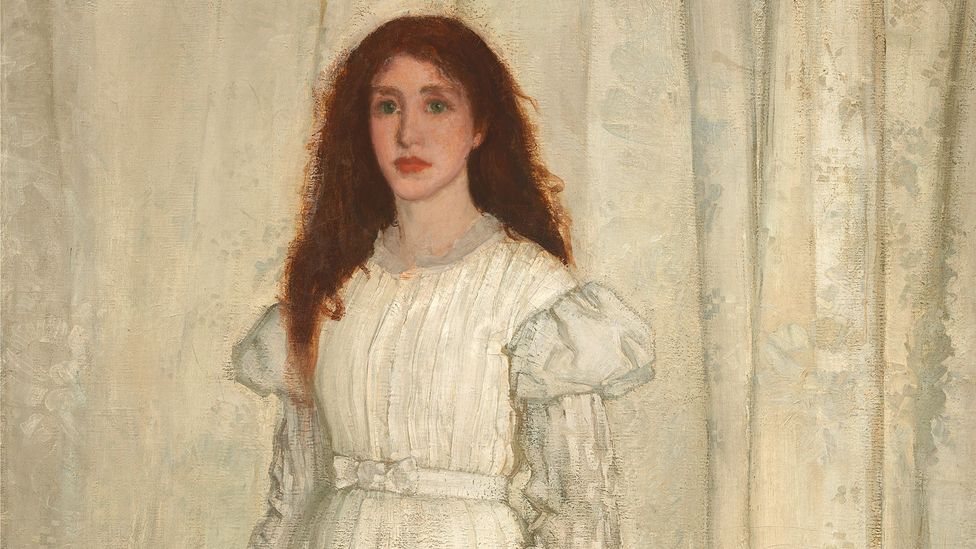
In art, spirituality and protest, a woman wearing white is a powerful symbol. Is she a goddess, a ghost, a "fallen woman" – or something else entirely, asks Beverley D'Silva.
S
She was a vision in a white dress, as she stood, or half floated, before a white curtain. She was an "apparition", enthused the artist Gustave Courbet. No, there was nothing ghostly or unearthly about her, according to the art critic Jules-Antoine Castagnary, she was "a woman after her wedding night," he said, leaving no doubt what her rosebud lips and dazzled stare evoked in him. She was "charming" felt the poet Charles Baudelaire. While art historian Paul Mantz wondered: "What does she want with her loose hair, her big eyes drowned in ecstasy, her languid attitude?"
More like this:
- Tragedy of the world's first supermodel
- Unseen masterpieces of Frida Kahlo
- Paintings of 'rage, rebellion and pain'
The "she" invoking these notable reactions was the subject of The White Girl, a masterpiece created by artist James McNeill Whistler in 1861-2. The model, Joanna Hiffernan, was also a muse, companion and much more to the US-born artist, who was living between London and Paris when the pair met in 1860. At the time of their meeting, Hiffernan, an Irish-born Londoner, was 21. The artist was 26, smitten by her beauty, and her hair, which was "the most beautiful that you have ever seen!" he wrote. "A red not golden but copper – as Venetian as a dream!"
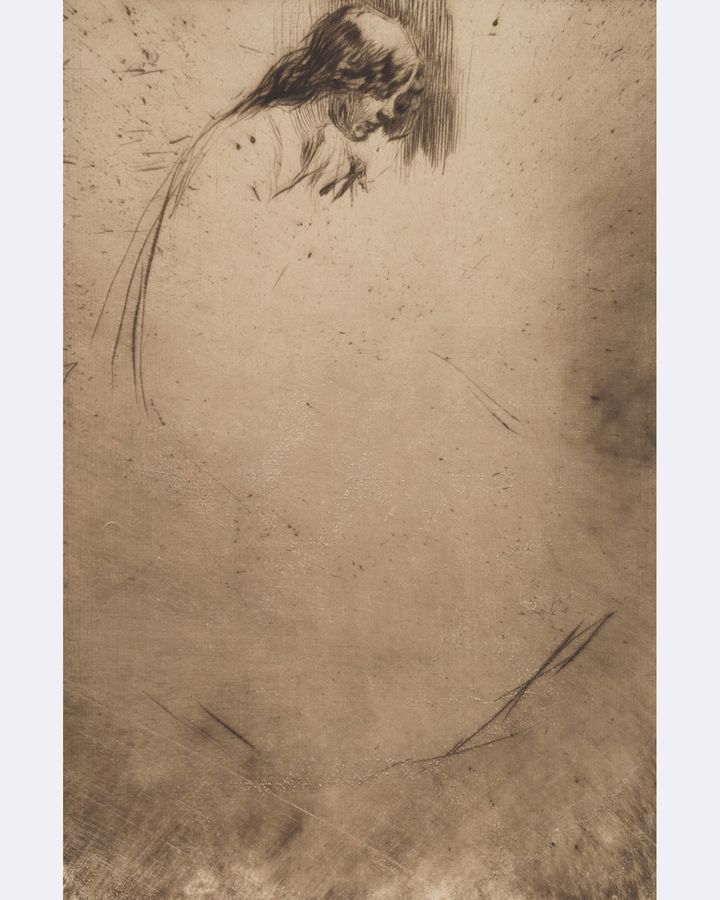
Jo's Bent Head (1861) was among Whistler's many portraits of his muse and partner, Joanna Hiffernan (Credit: University of Michigan Museum of Art)
The painting, which he eventually titled Symphony in White, No 1: The White Girl, was rejected by the Royal Academy and the official Paris Salon, and accepted at the Salon des Refusés in 1863, a home – thanks to Napoleon III – for fine artists rejected elsewhere. It sealed Whistler's fate as a great international artist, and won him huge success in his own time.
From its first showing in a London gallery, under the title Woman in White, trading up on the popularity of Wilkie Collins's 1859 novel of that name, it caused a stir, was derided publicly and critically praised. Like the Mona Lisa centuries before her, Woman in White drew fascinated crowds, speculating about who and what she was.
Much conjecture focussed on the dress. A robe of such dazzling light-suffused whiteness was surely a garment worn by saints and the Virgin Mary, with further allusions to purity and innocence invoked by the white lily in her hand. But what of the flame-red hair, hanging loose, possibly indicative of her morals? And the wolfskin beneath her feet; with its links to wildness, sexuality, and the "beast" waiting to be unleashed inside her – or maybe those who gazed upon her.
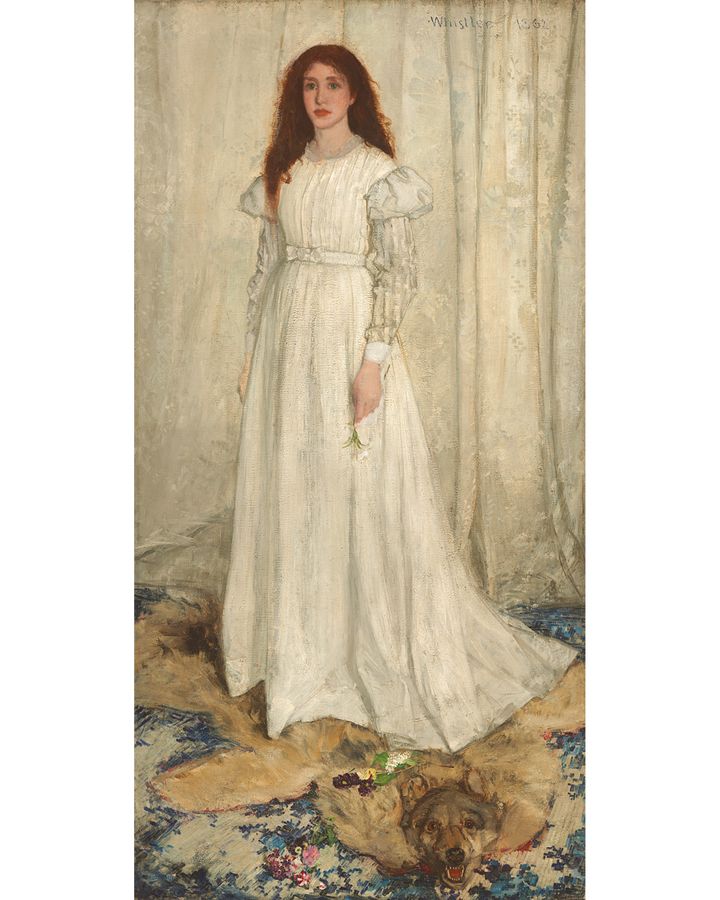
Whistler's iconic Symphony in White, No 1: The White Girl (1862), or Woman in White, has been interpreted in numerous ways (Credit: National Gallery of Art, Washington)
Controversy raged around these stereotypes – goddess or "fallen" woman – and what all that whiteness could possibly symbolise: purity, virginity, morality, heaven, goodness, faith, perfection. Whistler was a "ruthlessly ambitious and hard-working artist" who was "determined to make his mark", according to Professor Margaret MacDonald, a co-curator of an exhibition at London's Royal Academy, Whistler's Woman in White, as well as co-author of the accompanying book, who is an expert on Whistler. The book examines the complex, enduring relationship between the artist and Hiffernan, and explores how the sensation around The White Girl, which stood on the threshold of modern art, secured Whistler's place in art history.
While relishing the publicity it attracted, the artist stayed out of the debate on its white-on-white theme, famously retorting that it "simply represents a girl dressed in white standing in front of a white curtain" – in line with the "art for art's sake" credo he subscribed to. Yet despite his apparent insouciance, he painted "Jo" – as he affectionately called her – in white at least five times, three in his symphonies series. MacDonald tells BBC Culture that, in her view, Whistler's choice of a white dress was partly because it "contrasted splendidly with her hair", and the artist was excited by the technical challenge of painting white on white, a challenge the artist Auguste Renoir spoke later of sharing.
Whistler and Hiffernan's backgrounds couldn't have been more contrasting. He had a privileged childhood in New England, and grew up surrounded by wealth. Hiffernan came from a poor working-class family from Limerick in Ireland, who arrived penniless in London. She had considerable innate talents; she was (according to Whistler's biographers Elizabeth R Pennell and Joseph Pennell) of "next to no education, but of keen intelligence… [and] great charm of manner". MacDonald says that Jo and her sister Agnes (who were close) were "not quite on the streets… but it was very difficult for somebody with nothing to make a living in London. And they were beautiful, so modelling [for an artist] was certainly one option".
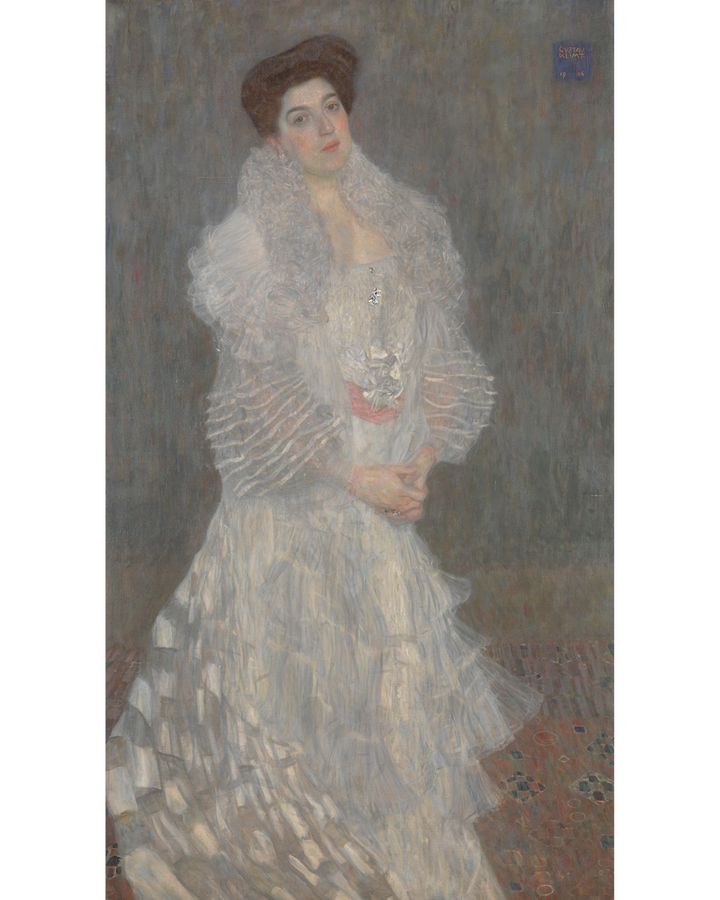
Gustav Klimt's famous Portrait of Hermine Gallia (1904) depicts the subject in a gauzy white gown (Credit: The National Gallery, London)
It was an option even if that modelling could be seen by "polite society" of her day as a fall from grace. And when Whistler first painted Hiffernan, he used vivid colours, and told his painter friend, Henri Fantin-Latour, she was like a "putain" (prostitute). Although they never married in the legal sense, their relationship would last 20 years – until her death – and she was vitally important to him. She not only posed for his best portraits – exposing herself in the process to lead white paint that may well have contributed to her death from a lung disease at 44 – she also cared for his son from an affair for many years, and sometimes managed his estate.
Her part in his great fame might have mostly gone unsung. But 160 years later, a fascinating spotlight falls on Hiffernan, her personality and their life together, as revealed in the Royal Academy exhibition.
MacDonald and her team were thrilled to discover, using X-radiographs, images buried under layers of some of his paintings (which he'd painted over to save on canvas) depicting Hiffernan "her eyes looking devoutly upward, as if to heaven", in the guise of "a woman praying, saint or a nun" as MacDonald puts it. "All possible spiritual interpretations of the model's expression at this stage."
"Incandescent beings"
White in artworks carries "a wide spectrum of meanings," says Marina Warner, historian, art critic and author of books including Stranger Magic, and Monuments and Maidens. "If it's shining, as it is with the curtain in The White Girl, it brings a sense of being close to light, and ideas of purity and cleanliness," Warner tells BBC Culture However, "shining white is also associated with angels, which are incandescent beings – candidus is Latin for white, and light is the origin of things. If you read Dante's Commedia [later known as The Divine Comedy], as you rise to heaven, it gets brighter and brighter. So that connection of whiteness with goodness is very, very strong."
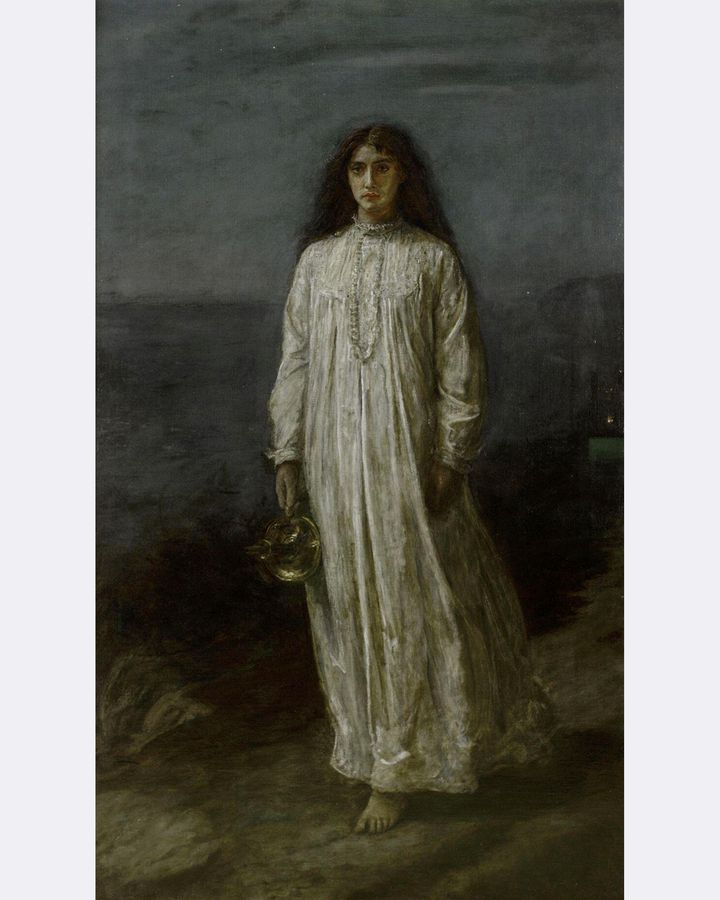
There is a phantom-like quality to John Everett Millais' The Somnambulist (1871) (Credit: Alamy)
The dress in the painting is "not shiny" she points out "and in this she's less angelic than nubile. Also a strong symbolic meaning of whiteness is a threshold – if you're a candidate or a novice up to become a nun, you wear white, as you do for your first communion; and if you marry you wear white and pass across the threshold of maidenhead into the world of sexuality".
Warner notes the model's "red lips, and hair hanging loose, possibly a sign of availability. She looks apt to surrender without much of a struggle. A hint of dangerous sexuality in the wolfskin… even the flowers in the carpet are hinting at fruition or fertility". Indeed, the Woman in White curators believe Whistler's white-clad series may have been inspired by Jean-Baptiste Greuze's painting La Cruche Cassée (1771),"with its depiction of fair young flesh and a silky, disarrayed white dress," as MacDonald's book describes it. But as Warner says, white conveys a wide spectrum of connotations. She, like Courbet before her, finds the figure "rather spectral. I mean, in Victorian psychic photographs, ghosts are white, and there's something insubstantial, phantom-like about her. And of course, in many religions, whiteness is the colour of death".
The painting's success influenced striking works of that time, such as Frederick Sandys' Gentle Spring (1865); Sir John Everett Millais' The Somnambulist (1871); The Woman in White (1871) by Frederick Walker; Gustav Klimt's Portrait of Hermine Gallia (1904); John Singer Sargent's intriguing Fumée d'Ambre Gris (1880); and arresting portraits by Berthe Morisot, such as her The Artist's Sister at a Window (1869). MacDonald's co-author, Aileen Ribeiro, notes how Morisot "loved to depict these soft, floating, semi-transparent white morning gowns in private, informal, domestic settings". She references The Awakening Conscience by William Holman Hunt (1853), which "announces the sexual relationship between the young man and his mistress by specificity of her bedroom attire, a looser, striped white bodice over a white cotton broderie-anglaise petticoat… White then is an ambiguous colour; it can encompass a variety of meanings, from innocence to the lack of it"
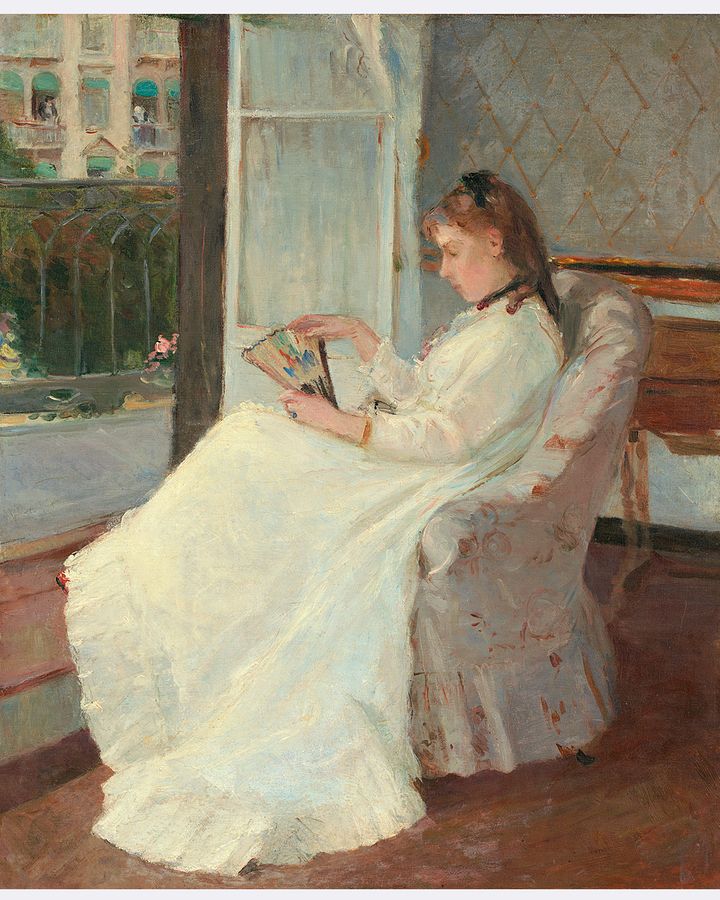
The Artist's Sister at a Window (1869) by Berthe Morisot depicts the subject in diaphanous white attire in an informal, domestic setting (Credit: Getty Images)
Writing on the symbolism of white in relation to fashion, Ribeiro observes: "It was Wittgenstein who said that white is 'that which does away with darkness', and for this reason is often linked to virtue, purity, cleanliness and humility". She lists the white toga virilis of ancient Rome, a symbol of the common good; white worn by monarchs at their coronations to underline their duty to the state and people; white associated with faith and religious rites, such as pilgrims to Mecca. There's the fact Popes have worn white since 1566, as a symbol of purity and sacrifice, and it's worn by priests and priestesses in the Shinto religion in Japan, where white has been an auspicious colour since ancient times.
Of course there are countless portrayals of white-clad figures in modern art, from Whistler via Klimt's women in dresses gauzy as butterfly wings, through to Picasso's Woman in White (1923) to the vivid self-portraits by Frida Kahlo. One of Kahlo's paintings in which white plays heavily with colour symbolism is The Two Fridas (1939). She depicts herself in two guises – one Frida in Western clothes, the other in a formal white dress with traditional Tehuana trimming, her exposed heart bleeding on to its white skirt; it's been suggested the white Frida was the life she wished to have but eluded her (children, and happiness with Diego Rivera, from whom she had recently divorced). Kahlo said the picture expressed her desperation and loneliness. Self Portrait with Thorn Necklace and Hummingbird (1940) is arguably her best-known work featuring herself: her white dress is like a crucifixion shroud, as a neckpiece of thorns, rather than a crown, pierces her skin.
White dresses as a tradition for weddings is not as long-held as we might think – in fact, it was Queen Victoria's choice of a white wedding dress finished in lace (to help the ailing lace industry), that inspired a public fashion for bridal white. Bridal fashion expert, Peta Hunt recently told wedding website hitched.co.uk that we will see "a lot more coloured wedding dresses – pinks, blues, blush" and a return of black wedding dresses "for high glamour and drama". Wearing white has figured as a protest tool for women since the early 1900s, notably the British and US Suffragettes. White is the colour "most associated with suffragists today," writes Erin Blakemore for National Geographic. "Long associated with youth, virginity and moral virtue, white suggested that women could be expected to vote for politicians and policies that would better society."
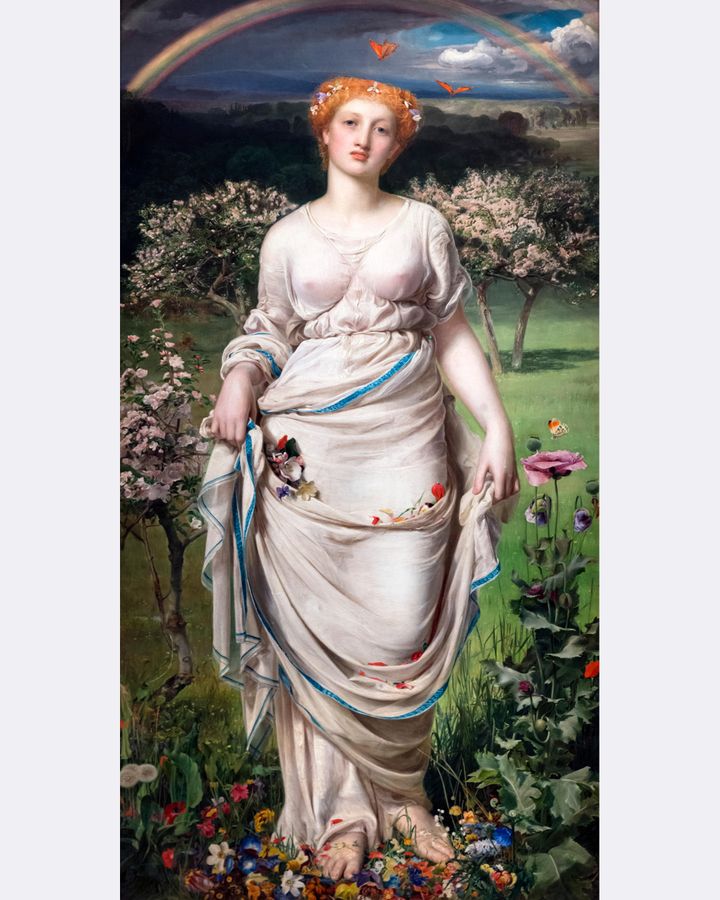
Frederick Sandys' Gentle Spring (1865) is among the many works to be influenced by Whistler's Woman in White (Credit: Alamy)
Wearing white, Emmeline Pankhurst strode out as leader of the Women's Social and Political Union, to promote votes for women at public marches, including the biggest demonstration of its time in the UK, in Hyde Park, June 1908. A long white dress, worn with purple (symbolising dignity, self-reverence and self-respect) or green (for hope and new life), became an easy-to-assemble uniform for Suffragists attending political rallies. White garments also stood out starkly against the crowds of men in dark suits – an early prototype of the clever photo op.
Wearing white to highlight gender equality – and as an emblem of female empowerment – is still very much with us. In 2019, Donald Trump faced a sea of suffragette white at his State of the Union address, as female Democratic members of Congress stepped up in pristine white clothes: "We'll honour those who went before us and send a message of solidarity, we're not going back on our hard-earned rights," said Lois Frankel, of the House Democratic Women's Working Group. While Christine Holgate, former Australia Post CEO, wore a white jacket when appearing before a Senate inquiry – part of the Wear White 2 Unite campaign to encourage people to support her call for an end to workplace bullying.
If she were still alive today, what would Joanna Hiffernan, the original Woman in White, make of the idea of white worn by women as a political statement? She'd probably snort with laughter, and be right behind it, judging by her wry humour and pragmatism, as revealed in the book. And what if she could walk around the Royal Academy, and witness the more than 70 paintings, etchings and Japanese prints that inspired her great friend, to see that the most eagerly sought-out artworks were of herself? That her talents and contributions to Whistler's oeuvre had at last been appreciated, and that she had finally been given her moment in the sun, would be gratifying indeed.
Whistler's Woman in White is at the Royal Academy, London, from 26 February to 22 May 2022.
If you would like to comment on this story or anything else you have seen on BBC Culture, head over to our Facebook page or message us on Twitter .
And if you liked this story, sign up for the weekly bbc.com features newsletter , called The Essential List. A handpicked selection of stories from BBC Future, Culture, Worklife and Travel, delivered to your inbox every Friday.
Source: https://www.bbc.com/culture/article/20220217-the-woman-in-white-the-meanings-hidden-in-a-masterpiece

0 Response to "Ghost in a White Dress and a White Veil"
Post a Comment